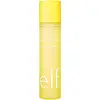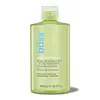What's inside
What's inside
 Key Ingredients
Key Ingredients

 Benefits
Benefits

 Concerns
Concerns

 Ingredients Side-by-side
Ingredients Side-by-side

Water
Skin ConditioningAloe Barbadensis Leaf Juice
Skin ConditioningGlycolic Acid
BufferingHamamelis Virginiana Water
AstringentGlycerin
HumectantButylene Glycol
HumectantSodium PCA
HumectantCitrus Limon Peel Oil
MaskingZinc Gluconate
Skin ConditioningPentylene Glycol
Skin ConditioningPPG-26-Buteth-26
Skin ConditioningPEG-40 Hydrogenated Castor Oil
EmulsifyingXanthan Gum
EmulsifyingSodium Benzoate
MaskingPhenoxyethanol
PreservativeEthylhexylglycerin
Skin ConditioningDisodium EDTA
Sodium Hydroxide
BufferingWater, Aloe Barbadensis Leaf Juice, Glycolic Acid, Hamamelis Virginiana Water, Glycerin, Butylene Glycol, Sodium PCA, Citrus Limon Peel Oil, Zinc Gluconate, Pentylene Glycol, PPG-26-Buteth-26, PEG-40 Hydrogenated Castor Oil, Xanthan Gum, Sodium Benzoate, Phenoxyethanol, Ethylhexylglycerin, Disodium EDTA, Sodium Hydroxide
Water
Skin ConditioningNiacinamide
SmoothingCamellia Sinensis Leaf Extract
AntimicrobialRosa Canina Fruit Extract
AstringentFomes Officinalis Extract
Skin ProtectingCucumis Sativus Fruit Extract
EmollientOryza Sativa Bran Extract
Skin ConditioningAvena Sativa Meal Extract
SoothingHamamelis Virginiana Leaf Water
AstringentSodium Hyaluronate
HumectantGlycerin
HumectantCopper Gluconate
Skin ConditioningMagnesium Aspartate
Skin ConditioningSorbitan Oleate Decylglucoside Crosspolymer
CleansingZinc Gluconate
Skin ConditioningGlycolipids
Skin ConditioningCaprylyl Glycol
EmollientPEG-40 Hydrogenated Castor Oil
EmulsifyingPolysorbate 20
EmulsifyingCaprylyl Glyceryl Ether
CleansingHexylene Glycol
EmulsifyingButylene Glycol
HumectantPropanediol
SolventSodium Phytate
Tetrasodium Glutamate Diacetate
Phenoxyethanol
PreservativeEthylhexylglycerin
Skin ConditioningCitric Acid
BufferingSodium Hydroxide
BufferingWater, Niacinamide, Camellia Sinensis Leaf Extract, Rosa Canina Fruit Extract, Fomes Officinalis Extract, Cucumis Sativus Fruit Extract, Oryza Sativa Bran Extract, Avena Sativa Meal Extract, Hamamelis Virginiana Leaf Water, Sodium Hyaluronate, Glycerin, Copper Gluconate, Magnesium Aspartate, Sorbitan Oleate Decylglucoside Crosspolymer, Zinc Gluconate, Glycolipids, Caprylyl Glycol, PEG-40 Hydrogenated Castor Oil, Polysorbate 20, Caprylyl Glyceryl Ether, Hexylene Glycol, Butylene Glycol, Propanediol, Sodium Phytate, Tetrasodium Glutamate Diacetate, Phenoxyethanol, Ethylhexylglycerin, Citric Acid, Sodium Hydroxide
 Reviews
Reviews

Ingredients Explained
These ingredients are found in both products.
Ingredients higher up in an ingredient list are typically present in a larger amount.
Butylene Glycol (or BG) is used within cosmetic products for a few different reasons:
Overall, Butylene Glycol is a safe and well-rounded ingredient that works well with other ingredients.
Though this ingredient works well with most skin types, some people with sensitive skin may experience a reaction such as allergic rashes, closed comedones, or itchiness.
Learn more about Butylene GlycolEthylhexylglycerin (we can't pronounce this either) is commonly used as a preservative and skin softener. It is derived from glyceryl.
You might see Ethylhexylglycerin often paired with other preservatives such as phenoxyethanol. Ethylhexylglycerin has been found to increase the effectiveness of these other preservatives.
Glycerin is already naturally found in your skin. It helps moisturize and protect your skin.
A study from 2016 found glycerin to be more effective as a humectant than AHAs and hyaluronic acid.
As a humectant, it helps the skin stay hydrated by pulling moisture to your skin. The low molecular weight of glycerin allows it to pull moisture into the deeper layers of your skin.
Hydrated skin improves your skin barrier; Your skin barrier helps protect against irritants and bacteria.
Glycerin has also been found to have antimicrobial and antiviral properties. Due to these properties, glycerin is often used in wound and burn treatments.
In cosmetics, glycerin is usually derived from plants such as soybean or palm. However, it can also be sourced from animals, such as tallow or animal fat.
This ingredient is organic, colorless, odorless, and non-toxic.
Glycerin is the name for this ingredient in American English. British English uses Glycerol/Glycerine.
Learn more about GlycerinPeg-40 Hydrogenated Castor Oil is derived from castor oil and polyethylene glycol (PEG). It is used as a emollient and emulsifier.
As an emulsifier, it helps prevent ingredients from separating. It also helps make the other ingredients more soluble; it is often used to solubilize fragrances. This increases spreadability and elongates shelf life in a product.
Emollients help soothe and soften the skin. They do this by creating a protective film on your skin. This barrier helps trap moisture and keeps your skin hydrated. Emollients may be effective at treating dry or itchy skin.
This ingredient may or may not be vegan, depending on the source.
Peg-40 Hydrogenated Castor Oil may not be fungal-acne safe. We recommend speaking with a professional if you have any questions or concerns.
Learn more about PEG-40 Hydrogenated Castor OilPhenoxyethanol is a preservative that has germicide, antimicrobial, and aromatic properties. Studies show that phenoxyethanol can prevent microbial growth. By itself, it has a scent that is similar to that of a rose.
It's often used in formulations along with Caprylyl Glycol to preserve the shelf life of products.
Sodium Hydroxide is also known as lye or caustic soda. It is used to adjust the pH of products; many ingredients require a specific pH to be effective.
In small amounts, sodium hydroxide is considered safe to use. However, large amounts may cause chemical burns due to its high alkaline.
Your skin has a natural pH and acid mantle. This acid mantle helps prevent harmful bacteria from breaking through. The acid mantle also helps keep your skin hydrated.
"Alkaline" refers to a high pH level. A low pH level would be considered acidic.
Learn more about Sodium HydroxideWater. It's the most common cosmetic ingredient of all. You'll usually see it at the top of ingredient lists, meaning that it makes up the largest part of the product.
So why is it so popular? Water most often acts as a solvent - this means that it helps dissolve other ingredients into the formulation.
You'll also recognize water as that liquid we all need to stay alive. If you see this, drink a glass of water. Stay hydrated!
Learn more about WaterZinc gluconate has antibacterial and wound healing properties. It is particularly effective against fighting inflammatory acne.
This ingredient is the zinc salt of the PHA gluconic acid. PHAs are gentle cousins to AHAs.